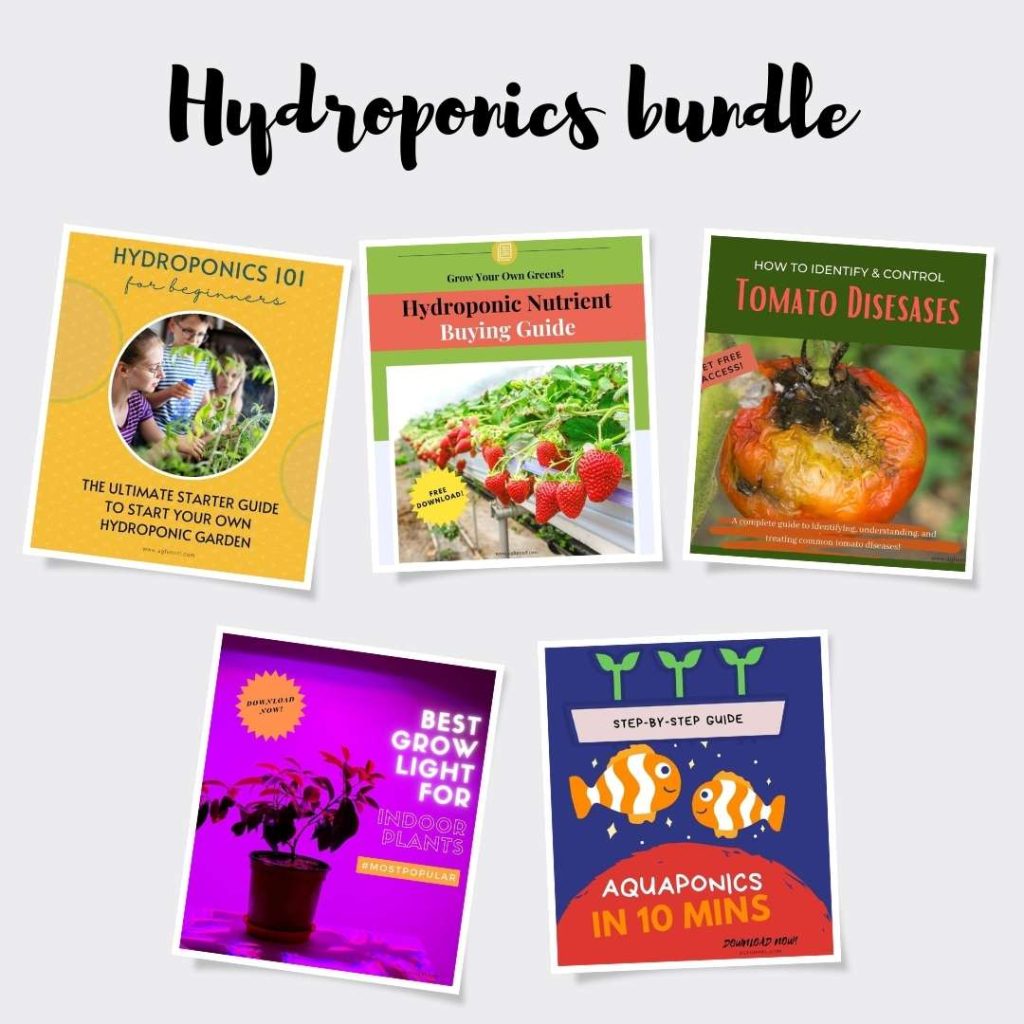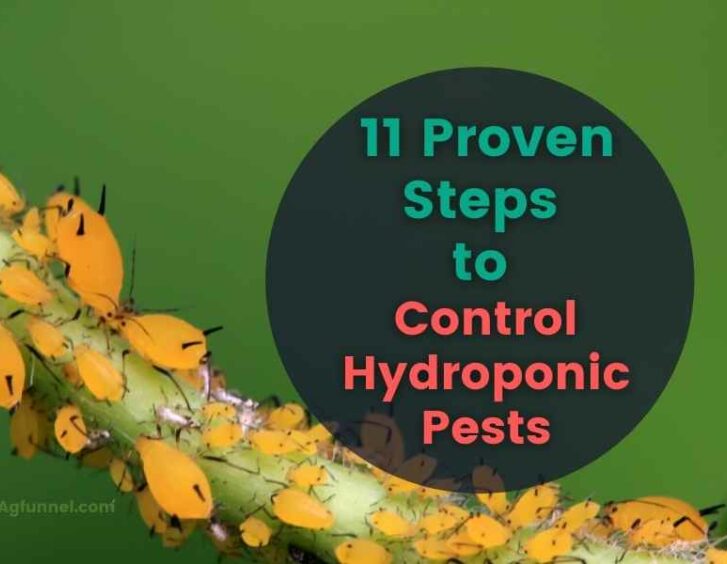Are you wondering about the tiny white bugs in hydroponics? or want to know how to get rid of fungus gnats in hydroponics? Get some ideas and tips on hydroponic pest control? Then this blog is right for you! In this article, we will talk about 11 steps you can take to prevent the most common pests in your hydroponic veggie garden environment and managing them! Let's start!
What Are The Most Common Hydroponic Pests To Be Aware Of?
Here are the common pests in hydroponics are:
Spider mite
Spider mites are a common problem in hydroponic gardens. They look like small dots on the leaf of the plant. Because they travel quickly and have tiny sizes, identifying them is difficult. Spider mites prefer hot, dry climates, but they can survive almost anywhere if there is enough food for them to eat. And since many people don't realize their plants have a problem until it's too late, spider mites often go unchecked for months before being discovered. It may be spider mites if you see webbing around the edges of leaves or a plant. Miticides are usually used to kill spider mites.
.jpg)
Whiteflies
Whiteflies are winged insects closely related to aphids and mealybugs. They are small, light, and fly around in a group.
Aphids
Aphids can be green, yellow, black, or brown. They produce a sweet substance called honeydew, a good food source for ants. Aphids can cause infection in the plants and damage them in ways such as young leaves turning yellow suddenly or the plants stopping growing.
.jpg)
Now you know some of the most common pests in your hydroponic garden, let's look at the pest management tools for effective hydroponic pest control:
1. Positive Pressure Grow Rooms
They are designed to maintain constant positive pressure in the grow room. This is done by using an exhaust fan that pulls air out of the system and then pushing it back into with another one or more fans, so there's always fresh filtered intake coming from outside.
2. HEPA Intake Filters
The HEPA filter is one of the most effective hydroponic pest management tools. They are designed to remove 99.97% of particles as small as 0.3 microns from the air intake before they enter your grow room and contaminate it with pathogens like mold spores.
HEPA Filter Air Purifier | 24db Filtration System Air Cleaner Odor Eliminator Remove 99.97% Dust Smoke Pollen Dander
3. Vacuum Cleaner
A common and easy physical pest-management technique is using a vacuum cleaner. It sucks up any pests that are on the surface of your plants. Most people like using a vacuum cleaner because it's easy and quick, but you can also use other things, such as sticky traps.
4. Sticky Traps
Sticky traps can be used for monitoring pest populations and as traps. Sticky traps work well for catching small insects, including aphids and thrips.
One downside of using a sticky trap is that you cannot use these traps to kill the insects on the plant's surface but can only use them to catch free-flying insects around your garden.
Gideal 20-Pack Dual-Sided Yellow Sticky Traps for Flying Plant Insect Such as Fungus Gnats, Whiteflies, Aphids, Leafminers, Thrips
5. Biological Technique
The biological pest-management techniques involve using beneficial insects and other natural predators to control pests such as aphids, mealybugs, or spider mites.
Biological control is probably one of the best methods because there isn't any risk associated with using these products, as they are all-natural.
The most common biological pesticide include ladybugs which are most effective against aphids. Some other natural predators include Lacewing (Chrysoperla carnea) and Predatory Mites (Phytoseiulus persimilis). You can also buy predatory mites on amazon.
6. Organic Pesticide
Organic pesticides are substances that can be used to kill or repel pests in your garden. They are commonly used for hydroponic pest control. They include natural products such as insecticidal soap and pyrethrum.
The most common organic pesticide is insecticidal soap, disrupting the insect's cell membranes.
Insecticidal soap can control aphids, thrips, spider mites, whiteflies, or mealybugs, but it doesn't work well on aphids because they have a waxy coating that prevents the soaps from getting into their bodies.
Organic Pyrethrins are also natural pesticides. They are made from the chrysanthemum flower, and they will kill aphids, mealybugs (and more).
Pyrethrins work by attacking a pest's nervous system, which leads to death! These products can also be used in hydroponics systems.
The other common organic pesticides are Bacillus thuringiensis var kurstaki (Btk)and spinosad. Still, these products may not work with all pests, so you need professional advice before using any product on your system! BtK kills caterpillars, while Spinosads target mites.
7. Conventional Pesticides
Conventional or synthetic pesticides are substances that can be used to kill or repel pests. They include chemicals such as pyrethrum, diazinon (a type of organophosphate), malathion, etc.
8. Essential Oils
Essential oils can also be used as a pesticide for hydroponic pest control. These oils can kill insects by either suffocating them (making it difficult for an insect to breathe) or leading to death (for example, neem oil, peppermint oil, etc.).
Neem Oil is a natural pesticide and an effective hydroponic pest control tool. It is made from the seeds of an evergreen tree called Azadirachta indica, and it can be used on plants to kill insects such as aphids, whiteflies, or mealybugs (and more).
The neem oil will suffocate these pests by clogging their respiratory system, leading to death! Neems are great because they work for many different types of pests.
Organic Neem Seed Oil for Plants & Gardening (Plantonix) - Pure Cold Pressed Neem Bliss with High Azadirachtin Content
9. Spinosad
Spinosad is a biological pesticide that is derived from the fermentation of Saccharopolyspora Spinosa. This product can be used as an effective hydroponic pest control tool. It is most effective against caterpillars, mites (and more).
10. Ultrasonic Pest Repellent
Ultrasonic pest repellent is a product that emits frequencies in the ultrasonic range to scare pests away. Some insects can perceive ultrasounds, which can be annoying for them, so they will stay away from certain areas where it's used. This device does not harm humans, pets, or other living things, but it's best to use it in an open space. It could be a good addition to hydroponic pest control!
Ultrasonic Pest Repeller 6 Packs, Indoor Pest Control, Ultrasonic Pest Repellent, Indoor Pest Control for Home
11. Be Watchful
Regularly check the plants for signs of insects.
When pest infestations are detected, isolate the infected plants as soon as possible to prevent the pests from spreading.
Conclusion
In conclusion, there are many ways to prevent pests in a hydroponics system.
These include physical, biological, and organic pesticides and conventional pesticide products that can be used safely on plants if needed.
Preventive methods include positive pressure grow rooms and HEPA (high-efficiency particulate air) intake filters, which are effective hydroponic pest control tools.
There are also conventional and chemical methods and pest management tools that can prevent pests, including vacuum, sticky traps, and beneficial insects.
The best way to prevent these pests is to keep a close watch!
These methods should help you manage all types of unwanted guests in your hydroponic garden!
Read this article to learn more about "Common problems associated with hydroponics and how to solve them."

Getting Started In Hydroponics? Download our ultimate starter guide to build your own hydroponic system
FAQs
Are pesticides used in hydroponics?
Yes, many different types of pesticides can be used in hydroponics.
What type of pests should I expect to see in hydroponics?
Different environments will create a variety of pests, and you may want to take preventative measures against any type. But some common plants include aphids, spider mites, thrips, and whiteflies.
How to tell if you have spider mites in your hydroponics?
Spider mites can look like small dots on the leaf of the plant. If you see webbing around the edges of leaves or a plant that seems to have an unusual amount of dead spots, it may be spider mites.
Are root aphids bad?
Yes, aphids are bad, can damage the plant, and must be eliminated.
What are some good techniques for pest management in hydroponics?
Some effective and easy tools for hydroponic pest control include using sticky traps, beneficial insects, or biological controls like a ladybug or predatory mites. Conventional pesticides will also work for most pests.
Is Neem oil safe for humans?
Neem oil is safe for humans and can be used as an organic pesticide.
What is pyrethrin?
Pyrethrin is a type of insecticide that is made out of chrysanthemum flowers or extracts from them.
Can nematodes hurt my hydroponics?
Yes, some nematodes can attack plant tissues, whereas some live in the media and feeds on the plant roots.
How do you prevent fungus in hydroponics?
Fungus is more likely to develop in hydroponics because of the high moisture levels. Controlling humidity and applying natural fungicides may be helpful.
How to tell if you have fungus gnats?
If you see small flies or gnats in the hydroponics system, fungus gnat larvae have likely fed on plant roots and then pupated.
How do you prevent fungus gnats?
The most important thing is to keep plant roots healthy and clean by removing any infected or dead plants from the system. Also, have a good ventilation system.
How do you control fungus gnats?
There are many ways we can get rid of them, but one way is by using an insecticidal soap spray with organic ingredients or using neem oil as the active ingredient.
What causes brown roots in hydroponics?
Brown roots are the result of an unhealthy plant. The problem might be due to too little oxygen (because of the build-up of bacteria and fungus on roots), low humidity, or insufficient water in the system.
What are ways to control brown roots?
Wash roots briefly in soda water to get rid of bacteria and fungi. Also, you can check if adequate ventilation and good aeration and adjust it accordingly.
How do you get rid of aphids in hydroponics?
You will need a trap or pesticide product like insecticidal soap, neem oil, etc.
How to get rid of whiteflies?
Whiteflies are a type of pest in hydroponics that can be managed using organic products like neem oil, insecticidal soap, and pyrethrins.
How to get rid of thrips in hydroponics?
Thrips can be managed with a product like pyrethrins.
How to get rid of mealybugs in hydroponics?
Mealybugs are hard to manage, so try using neem oil, insecticidal soap, and other organic products.
Are Fungus Gnats A Common Pest In Hydroponic Systems?
Yes, fungus gnats are a common pest in hydroponic systems. They thrive in the moist environment and can quickly infest your plants. To eliminate pesky fungus gnats, consider using sticky traps, beneficial nematodes, or hydrogen peroxide drench. Maintaining proper hygiene and avoiding overwatering can also help prevent infestations.
What are good hydroponic pest control products?
There are several hydroponic pest control products. Read this article to learn more about products recommended for hydroponic pest control.

Learn everything about hydroponics, from the basics to advanced techniques.
























